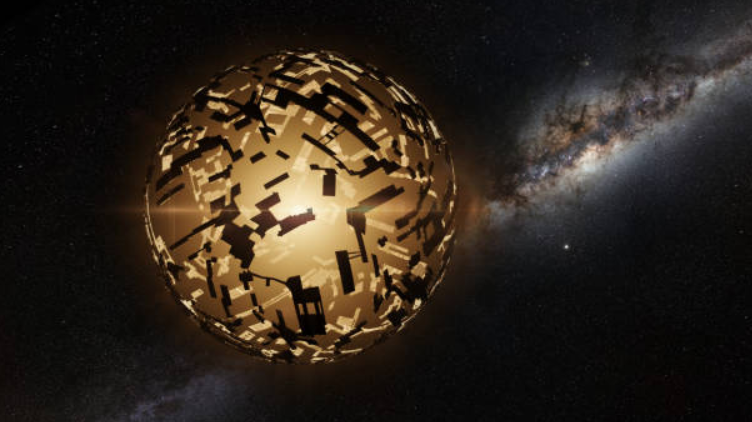Astronomers examined 260,000 stars in order to discover extraterrestrial megastructures within the Milky Way galaxy.
A group of scientists made a voyage to calculate how many Dyson Spheres could be built around stars in the Milky Way, paying attention to the necessity of forming a basis for an examination into the quest for extraterrestrial life. Through this study, Macy Huston, a graduate student at Penn State and co-author, emphasized the need to set upper limits in the future streams, as failure to achieve the desired outcome can still yield useful information. The results of their work are summarized in the study which is stored on the freely accessible preprint server arXiv.
WHAT IS A DYSON SPHERE?
The term Dyson sphere is applied to an idea of a huge structure that is placed around the star to collect all its energy produced. Conceived by physicist Freeman Dyson in 1960, it was a proposed framework that saw advanced alien civilizations use the limitless energy pool of their Sun for their day to day needs. Through gathering energy from the sun through a system of solar panels in space, these civilizations could achieve enough energy to maintain the stability of their society.
Dyson had found this out while pondering, that planets only take a small part of the energy that create through the solar stars. In example, the Earth only receives little sunlight from the Sun while it has almost infinite sunlight.
The construction of a Dyson sphere type structure could in theory significantly transform energy manipulation and appearance, and even elevate civilizations to a whole new level. But, the technology to achieve such a purpose seems beyond today’s know-how which would be a strong indication of a highly potent alien race. As well as this, Dyson also proposed that the search for extraterrestrials should include the examination of infrared radiation sources alongside radio signals. In the search of these theoretical megastructures, researchers need to take into account the fact of non-finding of what they might not be able to find.
To get a better understanding of the existing population within the Milky Way, researchers use data from the Gaia Observatory and the AllWISE program, analyzing the environment of 260,000 stars. Using simplicity of these stars, the team was able to develop models of the Dyson Spheres, and red a planetary figure of 300 Kelvin could be, and percentage of the star they would cover (10-90 percent). Working with others a similar model was then developed and the observations on the stars’ temperature and luminosity were used to compare the models.
On this base, the researchers succeeded to reveal the quantity of stars in the sample that could possibly become the ultimate settlements inside Dyson sphere simulations. Researchers have demonstrated that within this set of 260,000 stars, only 1 out of 1,000 stars can sustain a temperature of approximately 300 Kelvin, under which Dyson sphere could envelope 10 percent of the star for optimal functionality. The number which is needed to have 50 percent piece of coverage: one star per 100,000 stars, whereas for 90% the limit goes lower than one per 100,000.
Nevertheless, it must be stated that, although the number of structures established in this way would be the upper limit, these identified artifacts would not be the absolute fact of the true Dyson spheres. The immediate infrared excess that was observed in these objects can have natural causes that haven’t been identified yet.
The first step is to decide on all the stars that have the capacity of holding up Dyson Spheres. They intend to concentrate their efforts on these stars to learn the existence of alien megastructures within the Milky Way.
“By analyzing the stars’ entire spectra, we can deduce major activities of the stars completely,” explains Huston. Even a careful comparison of their spectral energy distribution can rule out many objects close to the real Dyson spheres which are dust-like and have similar characteristics.
The team is excitedly waiting for the Gaia mission results this summer as it would foungry other data for studying the stars.)
Abstract: Dyson spheres are hypothetical megastructures built by advanced extraterrestrial civilizations to harvest radiation energy from stars. Here, we combine optical data from Gaia DR2 with mid-infrared data from AllWISE to set the strongest upper limits to date on the prevalence of partial Dyson spheres within the Milky Way, based on their expected waste-heat signatures. Conservative upper limits are presented on the fraction of stars at G ≤ 21 that may potentially host non-reflective Dyson spheres that absorb 1 - 90% of the bolometric luminosity of their host stars and emit thermal waste-heat in the 100 - 1000 K range. Based on a sample of ≈2.7e5 stars within 100 pc, we find that a fraction less than ≈2e−5 could potentially host ∼300 K Dyson spheres at 90% completion. These limits become progressively weaker for less complete Dyson spheres due to increased confusion with naturally occurring sources of strong mid-infrared radiation, and also at larger distances, due to the detection limits of WISE. For the ∼2.9e8 stars within 5 kpc in our Milky Way sample, the corresponding upper limit on the fraction of stars that could potentially be ∼300 K Dyson spheres at 90% completion is ≤8e−4.
Do not forget to share your opinion with us to provide you with the best posts !




0 Comments